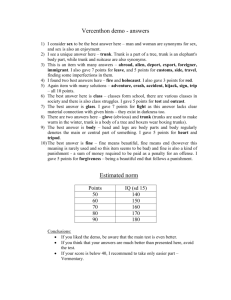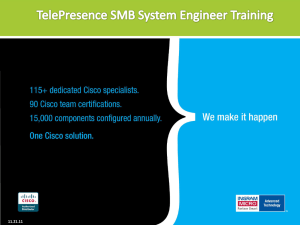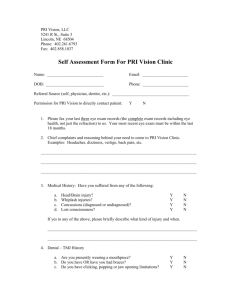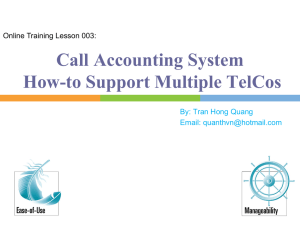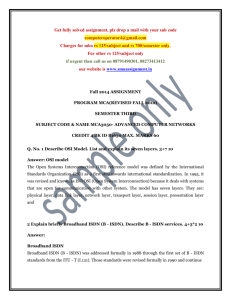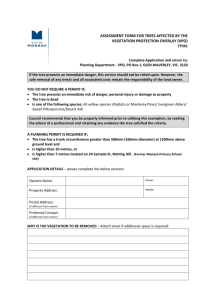Program Embedded PRI/QSIG Trunks
advertisement
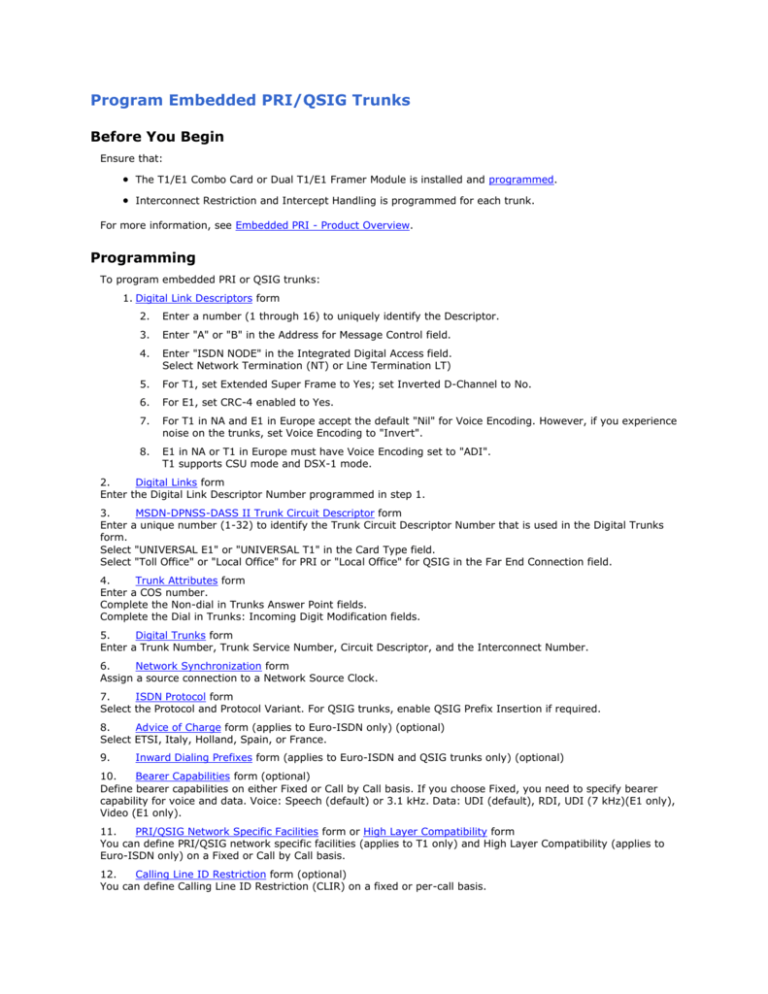
Program Embedded PRI/QSIG Trunks Before You Begin Ensure that: The T1/E1 Combo Card or Dual T1/E1 Framer Module is installed and programmed. Interconnect Restriction and Intercept Handling is programmed for each trunk. For more information, see Embedded PRI - Product Overview. Programming To program embedded PRI or QSIG trunks: 1. Digital Link Descriptors form 2. Enter a number (1 through 16) to uniquely identify the Descriptor. 3. Enter "A" or "B" in the Address for Message Control field. 4. Enter "ISDN NODE" in the Integrated Digital Access field. Select Network Termination (NT) or Line Termination LT) 5. For T1, set Extended Super Frame to Yes; set Inverted D-Channel to No. 6. For E1, set CRC-4 enabled to Yes. 7. For T1 in NA and E1 in Europe accept the default "Nil" for Voice Encoding. However, if you experience noise on the trunks, set Voice Encoding to "Invert". 8. E1 in NA or T1 in Europe must have Voice Encoding set to "ADI". T1 supports CSU mode and DSX-1 mode. 2. Digital Links form Enter the Digital Link Descriptor Number programmed in step 1. 3. MSDN-DPNSS-DASS II Trunk Circuit Descriptor form Enter a unique number (1-32) to identify the Trunk Circuit Descriptor Number that is used in the Digital Trunks form. Select "UNIVERSAL E1" or "UNIVERSAL T1" in the Card Type field. Select "Toll Office" or "Local Office" for PRI or "Local Office" for QSIG in the Far End Connection field. 4. Trunk Attributes form Enter a COS number. Complete the Non-dial in Trunks Answer Point fields. Complete the Dial in Trunks: Incoming Digit Modification fields. 5. Digital Trunks form Enter a Trunk Number, Trunk Service Number, Circuit Descriptor, and the Interconnect Number. 6. Network Synchronization form Assign a source connection to a Network Source Clock. 7. ISDN Protocol form Select the Protocol and Protocol Variant. For QSIG trunks, enable QSIG Prefix Insertion if required. 8. Advice of Charge form (applies to Euro-ISDN only) (optional) Select ETSI, Italy, Holland, Spain, or France. 9. Inward Dialing Prefixes form (applies to Euro-ISDN and QSIG trunks only) (optional) 10. Bearer Capabilities form (optional) Define bearer capabilities on either Fixed or Call by Call basis. If you choose Fixed, you need to specify bearer capability for voice and data. Voice: Speech (default) or 3.1 kHz. Data: UDI (default), RDI, UDI (7 kHz)(E1 only), Video (E1 only). 11. PRI/QSIG Network Specific Facilities form or High Layer Compatibility form You can define PRI/QSIG network specific facilities (applies to T1 only) and High Layer Compatibility (applies to Euro-ISDN only) on a Fixed or Call by Call basis. 12. Calling Line ID Restriction form (optional) You can define Calling Line ID Restriction (CLIR) on a fixed or per-call basis. 13. Enable QSIG Digital Link Descriptors form Set the Integrated Digital Access option to ISDN Node. Set the QSIG Private Network Access option to Yes Shared System Options form Set the DPNSS/QSIG Diversion Enabled option to Yes If required, set the Maintain Original Forward or Reroute Reason to "Yes". With this option enabled, the system maintains and displays on the nominated party's telephone or console the original reason for forwarding or rerouting a call. MSDN-DPNSS-DASSII Trunk Circuit Descriptor form Set the Far End Connection option to Local Office 14. Set up Calling Party Number Substitution (optional; for PRI and BRI trunks only): 15. For DID-based substitution, complete the DID Ranges for CPN Substitution and CPN Substitution forms. 16. For DN-based substitution, complete the Associated Directory Numbers form. 15. ISDN Outgoing Numbers form (Euro ISDN Standard trunk variants only) (optional) This form allows you to select the outgoing numbering plans for Euro ISDN Standard trunk variants. To meet the specific ISDN requirements of a European region, you can select the Calling Number and Called Number parameters. 16. Set up number manipulation on the called and/or calling party number (optional; for Euro ISDN Standard trunk variants only): Inward Dialing Modification form Configure rule(s) for altering the dial strings in the inbound calls. ISDN Called Number Inward Dialing Number Modification form Choose the rules to apply to the called number (the number the caller is attempting to reach). ISDN Calling Number Inward Dialing Number Modification form Choose the rules to apply to the calling number (the call originator). NOTE: Inward Dialing Modification is applied AFTER Inward Dialing Prefixes are added to the incoming dial string. To avoid confusion, use one of these methods of modification only to alter the dial string.
